NAMES AND TAXONOMY
California Bay Laurel
Umbellularia californica (Hooker and Arnott) Nuttall
Also called the bay laurel, bay, California laurel, Oregon myrtle, myrtlewood (name used for wood used in furniture, carvings, and other products), pepperwood, and peppernut (the latter two from the aromatic wood and nuts), and headache tree (from its ability to cause and relieve headache with its aroma).
It is the only member of its genus, which was widespread in the Pliocene.
In the august family Lauraceae – the same family as the commercial avocado, the sweet bay from which comes the commercial cooking spice (commonly sold in whole-leaf form), and the laurel tree common in many mythologies, often featured as a symbol of peace and victory (ancient Olympic games champions were crowned with a laurel wreath, and the pigeon on Noah’s arc returned bearing laurel leaves, indicating the floodwaters had receded and land was nearby). The most gorgeous bird ever, the resplendent quetzal, also feeds exclusively on fruits of lauraceous trees in the neotropics.
HABITAT AND IDENTIFICATION
It is locally dominant in moist soils of mixed forests, redwood forests, and in coastal foothill canyons, slopes, and streambanks. It’s commonly cultivated around its endemic range (coastal mid to northern CA and southern OR). Its understory is often made open by allelopathic leaf litter, being sometimes totally barren of any plants under the main portion of the tree’s canopy.
Its trunk and branches are thick and smooth when young, developing pale low ridges with age; somewhat oak-like. Often it’s single-trunked in cultivated or upland habitat, but more often it’s multi-trunked on steeper slopes or along creeksides where its root tangles form banks.
Its heartwood rot and trunk/branch loss leaves hollows inhabited by small mammals. I’ve seen many trees toppled and killed with the base regrowing into a full, large, multi-trunked tree.
Its epiphytes are often extensive, being laden with thick moss is wetter areas.
It usually grows 40-70′ (max 150′). It has alternate branching, with simple, lanceolate, thick, shiny, dark, paler undersided, ~3.5″ long, and strongly aromatic leaves. It flowers Jan-Mar, in tiny yellowish clusters. Its fruit is avocado-like, green to purple, globular, and ~1″ wide. (Peattie 1950)
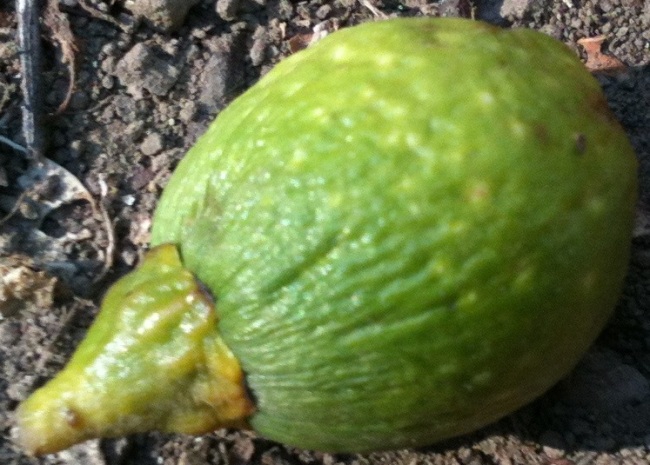
California Bay Laurel fruit on the ground.
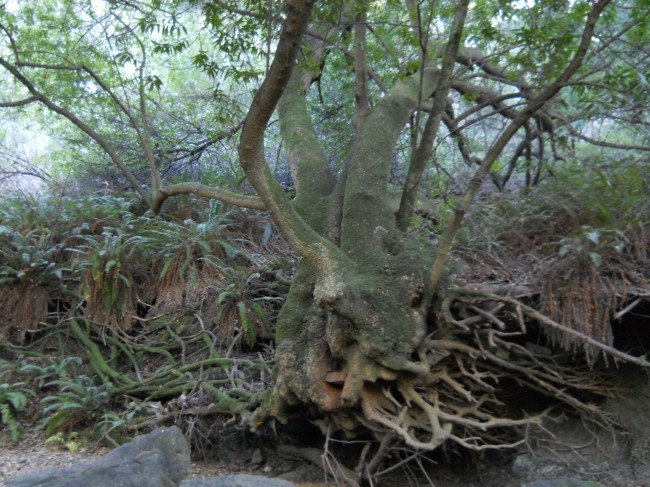
California bay laurel tree roots forming bank of stream in Wildcat Canyon
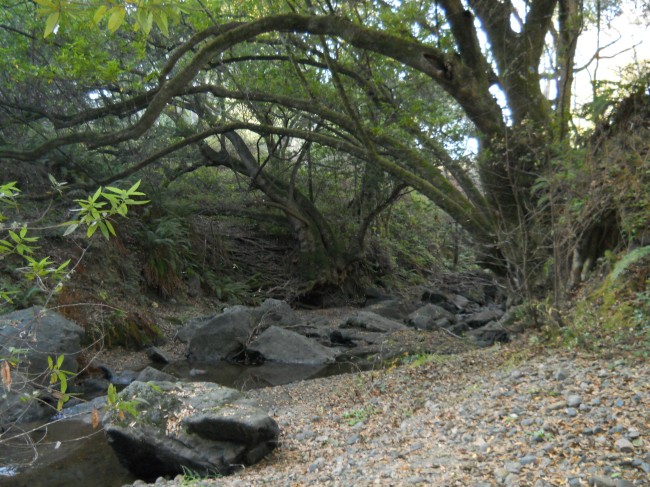
California bay laurel trees along creek banks in Wildcat Canyon
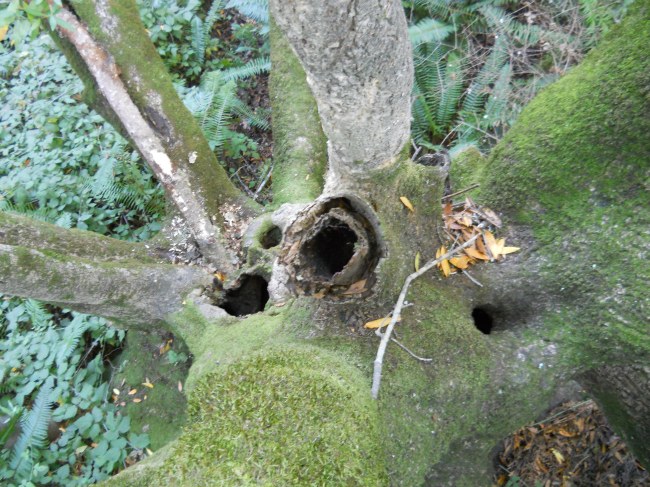
California bay laurel tree full of holes from dead branches, forming nice animal homes
A TREE OF MANY USES
The tree is really common in the CA bay area and has tons of uses, with edible fruits and nuts, leaves good as a spice, disinfectant / cleaner, flea repellant, de-licing agent, headache reliever (or inducer), toothache reliever, and more…
CARVING MYRTLEWOOD
The wood is very hard, firm, heavy green, medium-light dry (40.5 lb/ft2), and fine-grained, with mottled heartwood, and thick sapwood. It is often used for bowls and furniture (Peattie 1950).
It is subject to attack by bark beetles, so be sure to cure the wood, ideally with repeated coats of linseed oil and turpentine mixed, and once fully absorbed (waiting several weeks between coats and gradually decreasing the turpentine amount, beginning from 50%), a final coat of beeswax made workable with a little coconut oil.
THE BAY LAUREL FOR MEDICINE
Medicinal uses of the bay tree, especially its leaves, abounded for the CA Indians. The probable active ingredient for most or all of these medicines was umbelliferone, which is the essential oil that gives the tree its spicy, peppery, aromatic, or bitter taste in all its tissues.
These medicinal uses include:
– An infusion of leaves was used as an antimicrobial for washing sores or was drank for colds, sore throats, stomach aches, menstrual cramps, and clotting.
– A poultice of the leaves was applied to the affected tooth for relieving toothaches. Heated leaves were applied as a poultice for rheumatism. Bathing in hot water with the leaves twice a day for two or three days was a cure for rheumatism, causing the skin to smart, which provoked thorough rubbing (Chesnut 1902).
– The nuts were eaten during gorges of clover (Trifolium spp.) to prevent the bloating that would often otherwise occur.
– Fresh leaves were crushed and smelled to relieve headache, which could also induce one. To relieve headache, a piece of the leaf was placed in the nostril, or several leaves were bound to the forehead, or the head was washed with a strong decoction of the leaves (Chesnut 1902). My fiance suffered severe migraines following a severe head injury, and smelling crushed fresh or dried leaves was one of the few things that would relieve her headaches.
– For chronic stomach complaints, a large quantity of leaves was tied around the body for a couple of days (Chesnut 1902). To cure both stomachache and headache, a decoction was sometimes drank (Chesnut 1902). The vapor and smoke from burning boughs and leaves on a slow fire was a cure for many diseases (Chesnut 1902).
– Washing the head with a strong decoction of the leaves also was used to kill lice (Chesnut 1902).
BAY LAUREL LEAVES FOR FLEAS
Fresh boughs and leaves were placed around dwellings repel fleas and insects (Chesnut 1902). I do this at my house to reduce the flea infestation, and when I rub crushed leaves on my cats, I can see the fleas fleeing. An essential oil extract placed on the nape of my cats’ and dogs’ necks repels their fleas.
I boiled up a strong decoction from a large potful of leaves with which to wash my cats. The smell from the boiling pot was so powerful it gave me an instant headache, and I had to open all my windows and turn a fan on. Once the bay leaf decoction was cooled, I added some soap (to enhance penetration) and dipped my cats one by one into it, laving lots of the liquid over their whole bodies till they were totally soaked, while standing in a pot full. They hated it and the one we didn’t have in a mesh bag when we washed them bit the hell out of me and Emily. But I’m sure it was a terrifying headache for them.
Afterwards, I inspected their coats and the fleas were all dead or stunned. Checking later, it was clear that many were just stunned, and were slowly recovering as the cat dried. It was really easy to pick them off at this time, since they were slow, and easy to see in the wet coat. Next time, it will be better to wash the cats in the full tub of soapy water after the bay treatment to wash off the stunned fleas and send them down the drain.
I also used the soapy bay decoction in a spray bottle to totally coat the carpets, floors, and other areas the cats hang out to kill flea eggs.
THE BAY LAUREL FOR EATING
One interesting use I’ve only read about once was that the root bark was used to make a drink by the California Indians in Mendocino Co. (Chesnut 1902).
A few fresh or dried leaves make a great spice for hearty or meaty stews. Substitutable for commercial bay, though using less since it has a stronger flavor. I use about 3 or four mid-sized leaves (usually young leaves since older ones tend to have sooty mold) for about a gallon pot of bean stew or pot roast.
The fruit looks like a mini avocado, about 1-2 in long, with skin ranging from lime green to dark green and often with purple, some even being entirely rich purple. I have not found a relationship between the fruit skin color and the stage of ripeness beyond that when totally unripe they tend to be lighter green, not usually developing purple until ripe, but many ripe fruits are still totally light green.
The fruit, which ripens in the fall, has flesh that is edible, but unripe it is rather bitter. Ripe, it is still somewhat bitter or aromatic, but can often be quite tasty if one finds the right tree. A good ripe fruit tastes oily and like an aromatic avocado. The flesh is about half essential oils and fats. But I’ve found that most sufficiently ripe fruits are partly rotted or eaten or otherwise damaged. Perhaps picking them slightly unripe and allowing them to ripen in a paper bag would be a solution.
COLLECTING BAY LAUREL NUTS TO EAT
The bay laurel has edible nuts that were a common food among the California Indian tribes living within the tree’s range. They parched or roasted the nuts in their thin seed coat shell, which then splits easily, revealing the large kernel.
Some people these days eat bay laurel nuts:
http://rootedincalifornia.blogspot.com/2011/02/no-snow-and-california-bay-nuts.html
http://bushcraftusa.com/forum/showthread.php/79599-Bay-Nuts-I-eat-my-words!
I collected some bay nuts today, though the surrounding fruit flesh was very rotten on all of them. But that made it easier to squeeze the nuts out. A lot were already out of the flesh, just sitting on the ground in their nekkid seed coat. Close inspection of tooth marks revealed the fox squirrel (and perhaps some birds) was eating the fruit flesh and dropping the nut. Pretty surprising; I would think they’d prefer the nut to the flesh. But it was making my collection easier, so thanks Sciurus niger!
COOKING BAY LAUREL NUTS TO EAT
Raw, the oil-rich kernel is edible but a bit acrid. Cooked, the flavor is pleasantly peppery. A single family of Indians would use 3 or 4 bushels in a year, and even more were kept on supply by many (Chesnut 1902). Indians would eat only one or two dozen per meal (Chesnut 1902). These nuts were carried on long trips or when going a long time without food, being used for their stimulant properties (Chesnut 1902). They were often eaten with clover or were pounded up into a small mass, which being so oily, easily forms a cake of “bread” called pōl’-cum höt’-mil by the Yuki (Chesnut 1902).
Back home after collecting, I thoroughly washed the nuts, then let them them drip-dry a half hour (some were still damp when I put them in the oven). As per recommendation of a fellow flintknapper, Bill, a few weeks back as well as some of the above sites, I roasted my nuts in a convection (regular) oven at 450 degrees F, stirring every 3 or so minutes for a little over 20 mins total, until all the seed coats had cracked open, and the kernels changed from dull lime green to light greenish-brown or creamy brown.
Some were more well-roasted than others, but all of them were pretty good. They didn’t taste too much less bitter than the raw kernels, but I liked those pretty well too. I had to limit myself to only a few tonight since I didn’t want to be up late. I can’t wait to gorge myself on these in the morning and feel the stimulant effects!
I actually enjoy their peppery taste, and don’t expect wild plant foods to taste as bland as food you get in the grocery store. Aren’t things that are really good for you supposed to taste “bad” anyway, like brussel sprouts? A lot of people get turned off from wild foods when they find they taste surprisingly strongly of a flavor they’ve never tasted. But that’s actually one of my favorite things about foraging wild plants. Not to mention knowing those strong flavors are strong plant compounds that are bursting with vitality. Supermarket foods are as dull in taste as they are nutritionally void. I won’t go into the references but lots of studies show that wild plants have way more nutrition; macro and micronutrients, vitamins, minerals, active rna, etc. than what you find in grocery stores. In this respect, organic foods are not much better than conventional foods, and both are a chasm apart from wild foods! This holds for plant as well as animal foods.
UPDATE: After eating more of these and comparing the more to less roasted ones as well as getting feedback from another blogger (see his post http://paleotechnics.wordpress.com/2013/11/10/roasting-baynuts-in-a-popcorn-popper/), it became clear that lots of mine were not well enough roasted. They left a tingling, slight burning sensation in the back of my throat, compared to the well-cooked ones, which still had the same flavor, but without that lingering throat taste. My pictures show the kernels peeking through the seed coat crack that are still greenish and/or beige color… those are the unfinished ones. My main problem was not letting them dry first, or cook long enough. After putting the less cooked ones back in the oven for a few minutes again at 450, I got them all well done, and looking brown (see the above blog again for good pics of well-done nuts). Much better aftertaste for these now! They’re great with a little salt.
UPDATE 2: These are awesome if you grind them up (Emily, whose idea this was, used a blender) and make an infusion of (pour boiling water over) the powder! Smells and tastes like toasty cheerios, with a little bit of that zingy bay flavor. Since it has stimulant properties (though I haven’t felt much after several cups), this is a great coffee substitute!
UPDATE 3: BAY NUT COOKIES
For a recipe to make cookies out of bay nut flour and other CA native plants, acorns and manzanita berries, see my post “Winter Foraging”!
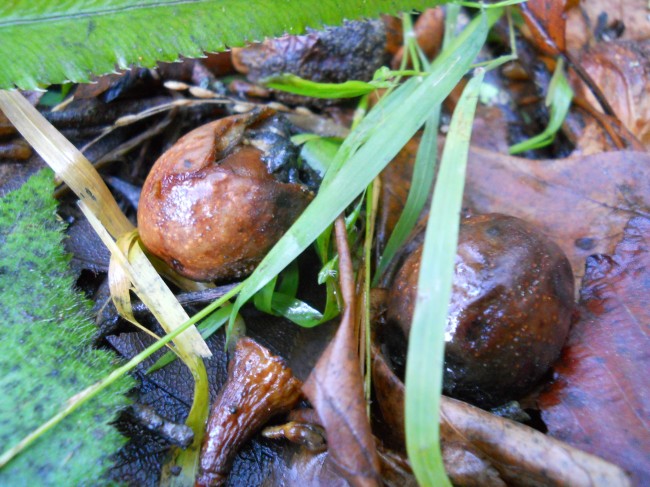
California bay laurel fruits rotten on ground, but the nuts are still great to eat
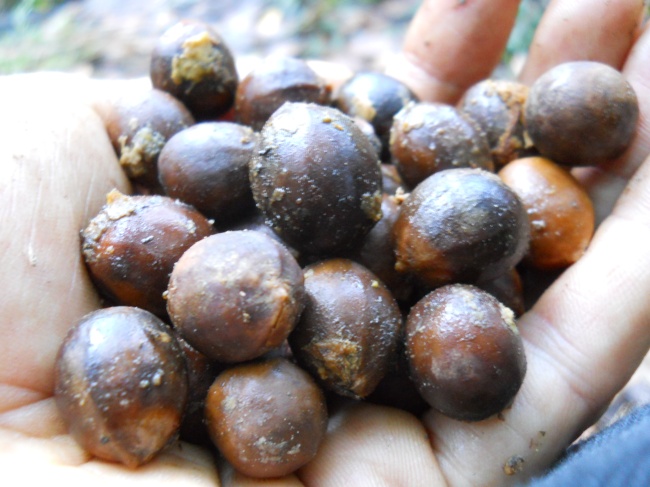
I collected this handful of California bay laurel nuts in about a minute
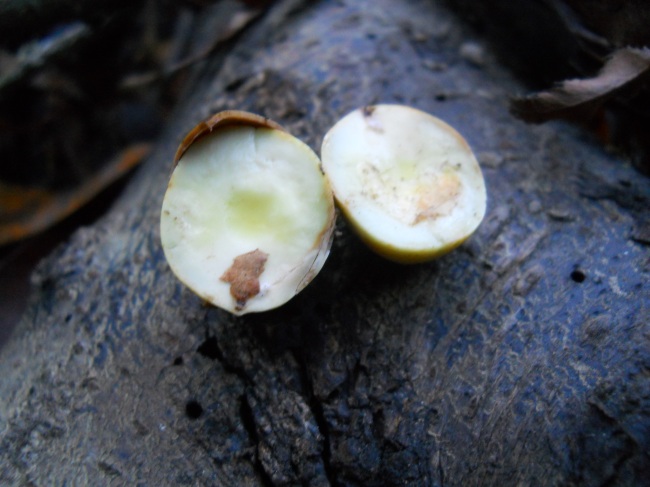
Kernel of California bay laurel seed naturally splits in two
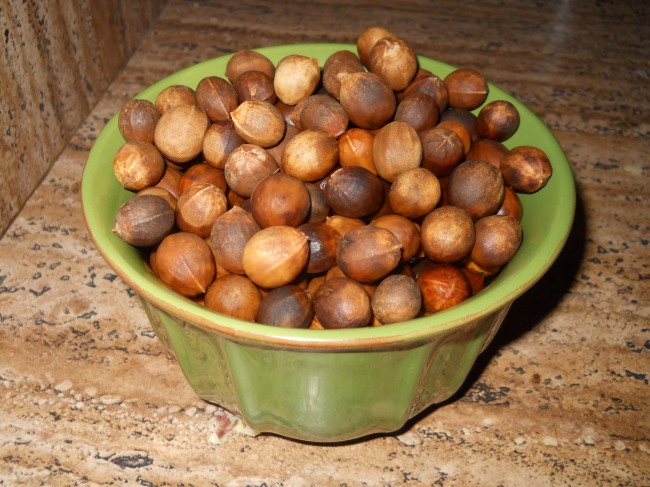
Bowl of washed fresh California bay laurel nuts
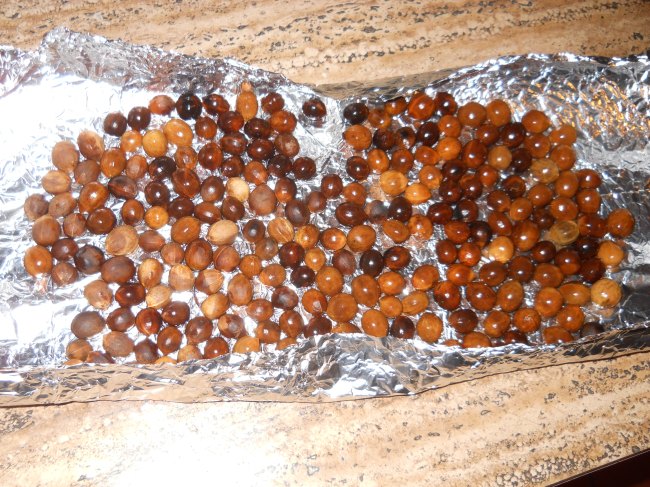
Washed fresh California bay laurel nuts ready to cook
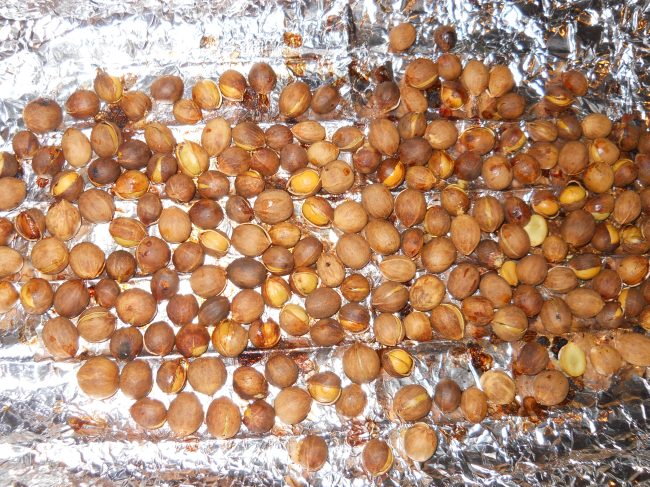
Cooked tray of California bay laurel nuts
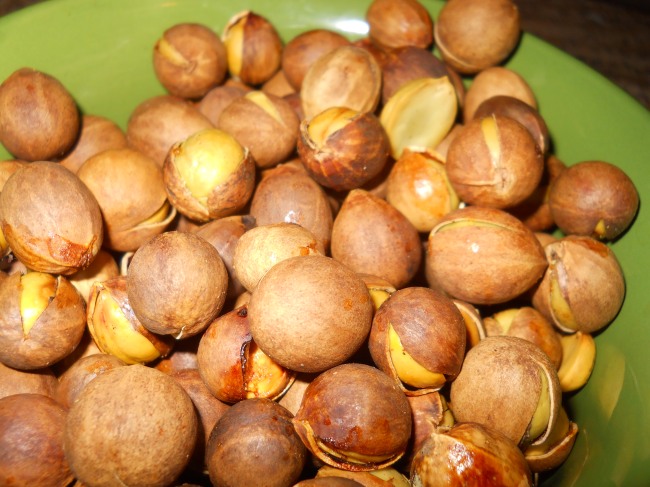
Close-up of bowl of cooked California bay laurel nuts
References:
Chesnut, V. K. 1902. Plants used by the Indians of Mendocino County, California. Government Printing Office, Washington, DC.
Peattie, D. C. 1950. A natural history of western trees. Houghton Mifflin Company, Boston MA.

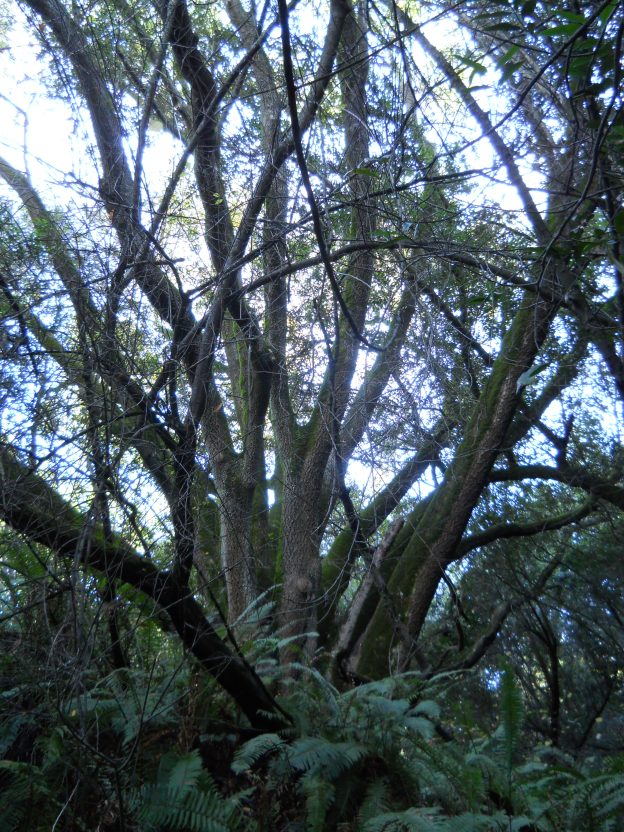
Nice article!
“It is the only member of its genus, which was widespread in the Pliocene.” I didn’t know that, though I have been wondering about Bay’s geographic and genetic origins. Do you have a source/reference?
Re: the flesh color. It’s not so much how ripe, it’s more about which tree they’re off. Some trees have no red or purple coloring. There is a tremendous genetic variation in fruit color, size and shape, thickness of flesh etc… I would think that bodes well for breeding potential.
Re: the wood. Yes it’s pretty, but it is also extremely well loved by a powder beetle. I’ve had finished objects attacked and ruined years after being made. They can probably treated or sealed to prevent infestation, but it’s a real problem. I think it may have to do with humidity, as in higher humidity= greater susceptibility.
Roasting green nuts never works out that well as far as I can tell. They tend to explode, and roast unevenly if at all. Roasting dry in a hot oven with frequent stirring seems the best way to drive off the acrid taste of the essential oils. Those oils are probably there to keep us from eating them. Well roasted nuts are still somewhat better, but not bitter in the way that irritates the back of the throat like raw and under roasted nuts do. You might try drying some first. Also, I’ve been using a popcorn popper lately, the kind that spins the kernels in a pan when you crank a handle. Here is a quick rundown on that: http://paleotechnics.wordpress.com/2013/11/10/roasting-baynuts-in-a-popcorn-popper/
Thanks for linking my post.
I think I got that info about the genus from Wikipedia, or maybe from Clarke’s Edible and Useful Plants of California.
Thanks for the info about the fruit color; now that you say it I think I’ve been seeing that pattern.
Also good to know about the wood; I carve sometimes but not yet using this wood. When I do I’ll make sure to give some good layerings of linseed oil then a coat of beeswax.
Thanks for your articles about the bay nut; from those I figured my operation wasn’t the best but for my first tries at least I’m opting for quick and dirty methods. After eating a lot more I noticed plenty of mine weren’t quite fully roasted and gave that back of throat tingling, while the well-roasted ones did not.
You’ve got some cool blogs going!
I know that Joe Dabill uses bay a lot for bows. He puts some kind of finish on them and hasn’t had any trouble. I’m thinking wood vinegar and then oil. I’d like to use the wood more. It’s really nice and tough.
Reblogged this on Ancestral Arts.